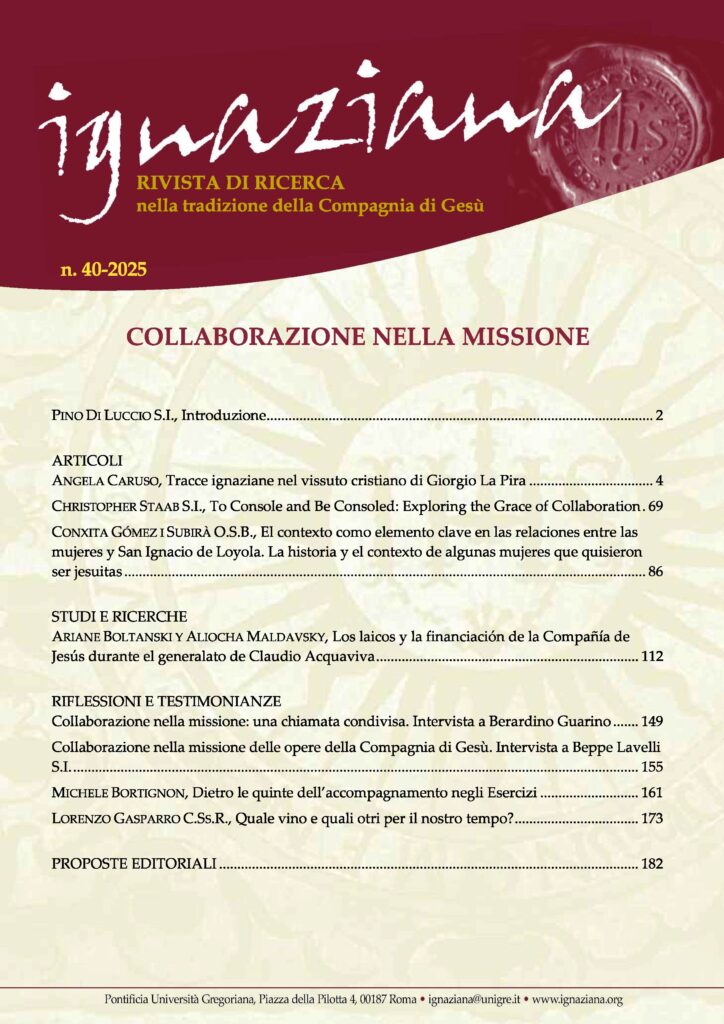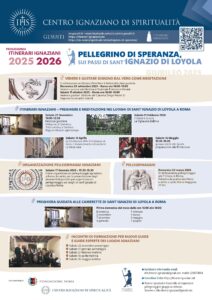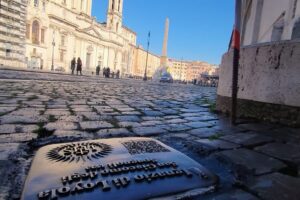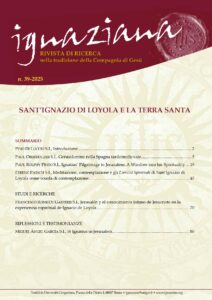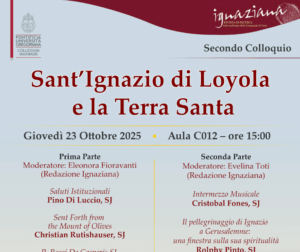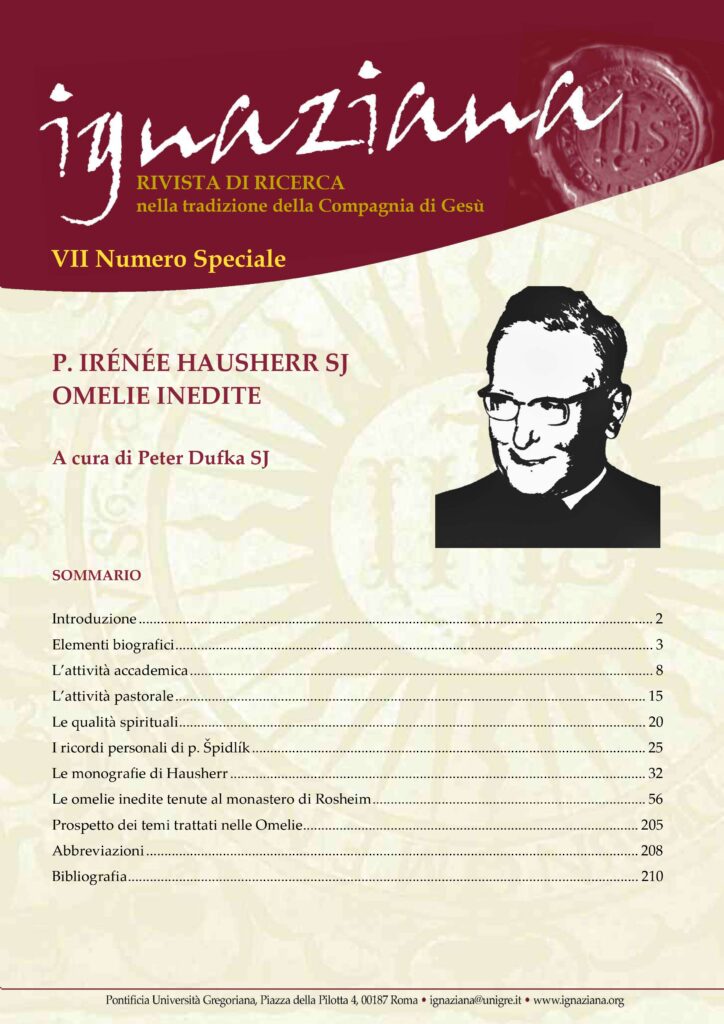di Miguel Ángel Garcia S.I. (Interviewed by Ferenc Patsch S.I.)
Abstract
Questo contributo è un’intervista che approfondisce il pellegrinaggio di sant’Ignazio di Loyola in Terra Santa nel 1523, ricostruendone l’itinerario attraverso fonti storiche e testimonianze coeve. L’esperienza di Ignazio, seppur breve, fu spiritualmente intensa e segnò profondamente la sua vocazione. L’intervista descrive i luoghi visitati, le difficoltà incontrate—tra cui il rifiuto dei Francescani di permettergli di restare—e l’impatto di questa esperienza sulla sua visione ecclesiale e missionaria. Viene inoltre illustrata l’evoluzione dei rapporti tra Gesuiti e Francescani e l’attuale presenza apostolica dei Gesuiti in Terra Santa, con un impegno particolare per la riconciliazione e il dialogo interreligioso.
This article is an interview that explores Saint Ignatius of Loyola’s pilgrimage to the Holy Land in 1523, reconstructing his journey through historical sources and contemporary accounts. Though brief, Ignatius’ experience was spiritually profound and pivotal to his vocation. The interview details the sites he visited, the challenges he faced—including the Franciscans’ refusal to let him stay—and how this shaped his ecclesial and missionary vision. It also outlines the evolving relationship between the Jesuits and Franciscans and highlights the current Jesuit apostolic presence in the Holy Land, with a strong focus on reconciliation and interreligious dialogue.
Keywords
Pellegrinaggio, Terra Santa, francescani, riconciliazione, dialogo interreligioso.
Pilgrimage, Holy Land, Franciscans, Reconciliation, Interreligious dialogue.
For us Christians, the Holy Land is dear because of the earthly life of Jesus Christ. However, those who know the Ignatian spirituality also know that St. Ignatius of Loyola made a pilgrimage here. What do we know about it?
We have several historical sources at our disposal that give us access to the experience of Ignatius in the Holy Land from his arrival on August 25 to his departure for Cyprus on October 1, 1523. Let us mention some of them briefly.
Ignatius devotes only paragraphs 46 to 48 of his Autobiography (AB) to recounting his pilgrimage to the Holy Land. Nevertheless, two of Ignatius’s fellow pilgrims inform us in greater detail about their itinerary. The first one is Peter Füssly, a Swiss. His diary was published in the Zürcher Taschenbuch in 1884, and again in the Studien zur Geschichte der Gesellschaft Jesu (Bonn: 1914). This was later edited by L.M. Uffer: Zürich: 1982). The other pilgrim is Philippe Hagen, from Strasbourg, whose diary was published along with three other journeys by pilgrims to the Holy Land, by L. Conrady, in Vier Rheinische Palaestina-Pilgerschrift (Wiesbaden: 1882, 230-289).
Then, Felix Fabri, a Dominican monk, provides interesting insights about his Holy Land pilgrimage in 1480, in his Evagatorium in Terrae Sanctae, Arabiae and Aegypti Peregrinationem (ed. By C.D. Hassler. I. Stuttgart: 1843). Finally, Fr. Francesco Suriano, a Franciscan Friar, who was the Custodian of the Holy Land from 1493, and again from 1512 to 1515, adds greater details about sites and the itinerary followed by Ignatius and his fellow pilgrims (see Il trattato di Terra Santa e dell’Oriente. Ed. By G. Golubovisch, Milan: Artigianelli, 1900). This work was later translated: Treatise on the Holy Land. SBF Collectio Maior 8. Jerusalem: Franciscan Printing Press 1949).
More recently, Maurice Gilbert, SJ, published his findings about Ignatius’ pilgrimage in “Le pèlegrinage d’Ignatius à Jérusalem en 1523”, Nouvelle Revue Théologique 112/5 (1990), 660-685; “La peregrinación de Íñigo a Jerusalén en 1523”, Manresa 63 (1991), 33-54; and, I Gesuiti e la Terra Santa, Rome: 2015. To the information provided by the sources referred to above, Gilbert added his detailed research and analysis done with manuscripts held in the Archives of the Custodia of Terra Santa as well as earlier historiographic publications on the topic. Then, Martin Manzano, SJ, published his Iñigo de Loyola. Peregrino en Jerusalén (1523-1524), Madrid: 1995.
Finally, we have Josef Mario Briffa, SJ’s recent publication Ignatius, A Guided Pilgrimage in the Holy Land (Messenger Publications, Dublin: 2023). This book makes a difference in that the author skillfully integrates the Holy Land’s history with his firsthand knowledge of the sites applying his expertise as an accomplished archaeologist of the Levant. Briffa comes up with a sound and insightful guide for Ignatian pilgrims to the Holy Land today.
In the Autobiography of St. Ignatius (AB), we read about his visit to Jerusalem and Bethlehem. What are the most important Ignatian Sites and what condition are they in? What was the itinerary that Saint Ignatius followed?
When Ignatius came to the Holy Land, many holy places, today restored, were in ruins or abandoned, except for the two basilicas of the Holy Sepulcher in Jerusalem, and of the Nativity in Bethlehem. Other relevant biblical sites were later discovered and excavated. So, let us refer only to the sites that Ignatius likely visited, as specified by the sources, and can still be visited today.
However, the reader of the Autobiography must bear in mind that Ignatius devotes only numbers 45-48 to speak about his visit to Jerusalem, written after 30 years circa of his pilmgrimage. And there he only mentions two places: the Mount of Olives and Bethphage. To define the likely itinerary of Ignatius visits in Jerusalem, we rather draw help from two reliable sources: the pilgrims’ itinerary provided by Füssli in his diary, which is similar to the one given by Suriano. The latter one gives in detail the programme of visits set for the pilgrims to the Holy Land.
The pilgrims disembarked in the port of Jaffo on September 1, and registered at the “Cellars of Saint Peter”. Both the Crusaders’ harbour and the caverns were dilapidated at that time. Nonetheless, today one can visit three restored vaults by the sea side and have an idea of the port’s topography at that time as well as its main structures at the time of the Crusaders.
On September 2, the pilgrims left for Ramla, located some 18 km South-East from the coast. On the evening of the following day, escorted by guards, they left for Jerusalem mounted on donkeys, probably via Bab el Wad, the Roman ascent, today’s Highway 1 to Jerusalem. That same night, they passed by Abu Gosh, home to a 12th century Crusader church located within the Cistercian Abbey of the Resurrection, housing communities of monks and nuns. Although the mosaics in the church were partially destroyed by iconoclasts, the temple was spared by the Muslim occupation. Today it is the best-kept Crusader church outside Jerusalem. The pilgrims went a little further up the valley and stopped at Acquabella, today the En Hemed National Park. The place holds the remains of the Crusader buildings, already dilapidated at the time of Ignatius. There, by a mountain water stream, the pilgrims rested for a few hours. They had already travelled uphill about 30 km along narrow mountain paths.
Before dawn, the pilgrims continued their way along the Valley of the Terebinths, the last lap of the journey. They arrived in Jerusalem at around 10 am. Before reaching the plateau, the pilgrim Diego Manes proposed to the group to dismount and walk in silence the remaining 3 km, where the Franciscan friars had come to welcome them.
The view of the city that Ignatius and fellow pilgrims had in 1523 was very different from that offered by the city today. West Jerusalem did not exist then, and the walls of the old city were not rebuilt until 1537.
On September 4, the pilgrims were welcomed at the Franciscan convent of Mount Sion, which was outside the old city as it is today. The cloister and the guest rooms for clerics, religious and priests, where Ignatius very likely stayed, are still there today, adjacent to the Cenacle. But the pilgrims were taken to Saint John Hospital, located to the south of the Holy Sepulcher. Pilgrims of the time said that their premises were in a pitiful condition. Today, the area’s name is ‘Muristan’ (from the Persian bimaristan, ‘hospital’), and is located in the Christian Quarter. Within its area are the Omar’s Mosk, residential buildings, a market, and the Greek Orthodox church of John the Baptist with its monastery. The Ecuestrian order of the Hospitaliers was founded there.
On September 5, following a pre-established itinerary organized by the Franciscans, the pilgrims celebrated Mass at the Cenacle. This group was the last to have celebrated the Eucharist in the Cenacle, until today. The Franciscan friars were evicted from their main convent in 1524. Then, the pilgrims visited the Tomb of David, today a synagogue on the premises’ ground floor, next to the cloister. Nearby lay the ruins of the Byzantine and Crusader churches of Mount Sion, where now stand the Church of the Dormition, consacrated in 1910, and the abbey of the Benedictine Monks of Beuron. In the afternoon, the pilgrims paid a long, guided visit to the Basilica of the Holy Sepulcher, beginning with the chapel of the Apparition of the Risen Lord to his mother. Then, they spent their first night in prayer at the basilica.
On Sunday, September 6, shortly before dawn, the pilgrims celebrated the Eucharist inside the aedicule of the Holy Sepulcher. At 6 am they went back to their lodgings. At 3 pm, they were led along the “Holy Circuit” that eventually became today’s Via Dolorosa, but in reverse order, leaving from the Holy Sepulcher towards the Ecce Homo Arch and reaching the Probatic Pool, in today’s Saint Anne Church’ compound, that hosts the community of the Missionaries of Africa. The “Stations of the Cross” included the House of Veronica (today’s 6th Station); then, around the trivium on the Tyropeon Valley, the house of Simon the Pharisee, and the place where Simon of Cyrene helped Jesus to carry his cross (today’s 5th Station); the place known as the Mary’s Spasm, commemorated in the crypt of the Armenian Catholic Church built in 1881 over a church in ruins (today’s 4th Station); the Arch of Pilate or Ecce Homo (cf. John 19:4-7); the House of St. Anne and birthplace of Mary; and the Probatic Pool (cf. John 5:1-14). These places are integrated into today’s Via Crucis. The return journey was via the church of Saint Mark, of the Syrian Orthodox Church; and the Armenian Orthodox Church of Saint James.
On September 7, after a Mass at the Cenacle, the pilgrims headed for the Kidron Valley, located to the east of the Old City. The pilgrims went past the Tomb of Absalon and reached the Garden of Olives. They went on to Bethany, where the Tomb of Lazarus can be visited today. They returned via Bethphage, visited the church of the ‘Pater Noster’ (Eleona), and the cave that commemorates the writing of the creed by the Apostles. They also visited the sanctuary of the Ascension, owned by the neighbouring mosque. Ignatius visited it unaccompanied later (AB 47-48). On their way down the Mount of Olives, the pilgrims stopped at the “Dominus Flevit”, the place that commemorated Luke 19:41-44: Jesus’ weeping over Jerusalem. Down the valley, the pilgrims stopped at the cave of Gethsemane near the site of Jesus’ Agony.
On October 8, the pilgrims went to Bethlehem, via Mar Elias and the Tomb of Rachel, both found along today’s Hebron Road, from Jerusalem to Bethlehem. There they visited the Basilica of the Nativity, a 6th-century building, and the church of Saint Catherine of Alexandria next to it. The saint’s altar is still placed on the right-hand nave of today’s church rebuilt in 1881. They also visited the cell of Saint Jerome, located under the church of the Nativity, next to the Nativity Grotto. It is said that here Jerome made the translation and revision of the Latin Bible, known as the Vulgate. The pilgrims spent the night in prayer at the Basilica.
On October 9, the pilgrims celebrated Mass in the cave of the Nativity and then left for Ein Kerem, the village that commemorates the Visitation, the Fountain of the Virgin and the birthplace of John the Baptist. On their way back to Jerusalem they passed by the Monastery of the Cross (Deir es Salib), then owned by Georgian monks. By the time of Ignatius, there was already an established tradition that in this place grew the tree from which the holy cross of Christ was made.
On October 10, the pilgrims departed from Mount Sion for Haceldama, the “Field of Blood” (Matthew 27:3-8) and its tombs, in the Hinnom Valley, south of the old city of Jerusalem. They also visited the pool of Siloam, with king Ezekiah’s 7th century BC underground Gihon spring outlet. The pool commemorated the healing of the blind man in John 9:1-7. Again, they went up the Kidron Valley and visited the Garden of Olives and the Tomb of the Virgin. An ancient, local tradition places the death of Mary in Jerusalem. The medieval entrance to the grotto takes the visitors down a 47-step-long staircase to the tomb. Today, as in Ignatius’ times, only the lower church survives with the rock-cut tomb, held to be that of Mary. Then, the pilgrims went back to Mount Sion. After the Vespers, they visited the houses of Caiaphas and of Annas, both Armenian churches.
On Friday 11, the activities took place at Mount Sion. The pilgrims visited the cave where tradition held that David composed his penitential psalms. This happened after his adultery with Bathsheba and the murder of Uriah. The place was located to the south of the Tomb of David, on the slope of Mount Sion, within the premises of an Ethiopian Orthodox monastery. Today, the place belongs to the Greek Orthodox Church. Here, the pilgrims were given a reception by the Franciscan Tertiaries. They were given the “Agnus Dei,” and relics. In the evening, the pilgrims returned to the Holy Sepulcher to spend a second night in prayer.
After a two-day rest, the pilgrims resumed their visits on Monday 14. On the Feast of the Holy Cross, at around 4 pm, they left for Jericho riding donkeys. There, they stopped at the “House of Zaccheus”, today marked only by a massive sycamore tree, which Zaccheus is supposed to have climbed to see Jesus, in the compound of the Russian Orthodox Church.
On Tuesday 15, the pilgrims went down to the Jordan River to visit Qasr al Yahud, the site that commemorates the Baptism of Jesus in Mark 1:9-11. Then, they returned to Jericho. Although their intention was to visit the Mount of Temptations, their escorts did not allow it. Finally, the pilgrims drank water at the Fountain of Elisha (Ain es-Sultan). Here, 2 Kings 2:19-22 tells us that the prophet changed poisoned water into drinkable one. The pilgrims returned to Jerusalem at night.
Let us go back a little bit into history. What else can we know historically about his stay in the Holy Land? Any particular experience worth sharing?
Earlier in his Autobiography, Ignatius refers to the great “consolation and determination” that the Lord gave him (AB 44). Ignatius summarized his stay in the Holy Land in only one sentence: “He always felt this same devotion on his visits to the holy places” (AB 45). Ignatius’ narrative aims to share his deeper spiritual experiences with the reader.
Ignatius narrated at length what took place on September 22, 1523. It is because he felt confirmed in his decision to stay in Jerusalem. So, Ignatius referred to us that he went to Father Guardian and shared with him about his project. Moreover, he supported his decision with letters of recommendation. Indeed, later Ignatius shared with the Franciscan Provincial that he “was very firm in his purpose and was resolved that on no account would he fail to carry it out” (AB 46). But, he did not disclose the purpose of his stay, namely, to help souls spiritually, even Muslims if possible. Ignatius himself shared the outcome of these conversations: the Franciscan Provincial’s refusal, Ignatius’ insistence, the Provincial’s threat of excommunication if he did not obey, and Ignatius’s acceptance of the Provincial’s decision without further appeal. What is most interesting is how Ignatius understood the failure of his original project: “It was not Our Lord’s will that he remain in those holy places” (AB 47). This experience helps us understand Ignatius’ “Feeling with the Church” in the Spiritual Exercises.
After knowing that he would go back to Jaffo with the group the following day, and without the permission of Brother Hugo, the Franciscan friar in charge of the group, Ignatius decided to go on his own to the edicola of the Ascension to make sure which direction looked the Lord’s feet when he ascended to heaven: “He remembered that he had not noted on Mount Olivet on what side the right foot was, or on what side the left” (AB 47). In the end, he does not tell us what he saw. But Ignatius did say that, on his way back descending the Mount of Olives, he put no resistance to the “belted Christian” who grabbed him and took him back to Mount Sion. Rather, he said that “it seemed to him that he saw Christ over him continually. This lasted all through in great abundance until he reached the monastery” (AB 48).
Indeed, St. Ignatius faced a difficult situation with the Franciscans. Could you elaborate more on this?
Ignatius’ discussions with the Franciscan Custos, and with the Provincial of the Holy Land then, referred to above, invite us to study the reasons why the Franciscans did not want Ignatius, or any other pilgrims at that, to remain in the Holy Land. Firstly, the friars lived very poorly, at times being able to feed themselves only once a day. They were aware of their inability to feed others who would be under their care. Therefore, they would not want pilgrims to remain in the Holy Land. Secondly, the life of the Christians in the Holy Land was very insecure. What the Franciscans certainly did not need was having to pay a costly ransom—with money they did not have—to liberate free-lance pilgrims from their captors. This explains why pilgrims were heavily escorted by soldiers under the Custody starting from the harbour of Jaffo through all the places they visited, and back to Jaffo to embark the vessel that would take them back to their places of origin. Finally, the time was very unsettling and the Franciscans knew it. The year after Ignatius’ visit, the Franciscans were evicted from the Cenacle –their main convent—on Mount Sion, by an order coming from the central command of the Ottoman empire in Istanbul. This was signed the very year Ignatius was in the Holy Land. By living and worshipping in the Cenacle, the Franciscans were accused of defiling an Islamic Holy Place. The Franciscans knew the risks involved better. At that time, they did not want anyone but themselves remaining in the Holy Land.
Today, half-jokingly, we can say that thanks to the wise refusal of Franciscans to let Ignatius remain in the Holy Land, there is a ’Society of Jesus.’
Ignatius never came back to the Holy Land, although he did hope to return. The vows of the first companions at Montmartre on August 15, 1534, still included that possibility (AB 85). When the project failed in 1537 (AB 94-96), the companions offered themselves to the Pope.
What was the connection between the Jesuits and the Franciscans later?
When Ignatius was the General of the Society of Jesus, Pope Julius III imposed on him a project that included a college in Jerusalem. Ten days before dying, Ignatius still reassured the Franciscan Order, who were strongly opposed to such a project. The college project did not materialize.
In the Last century, the Holy See decided to have a Holy Land outreach of the Pontifical Biblical Institute (PIB), entrusted to the Jesuits in Rome. So, a piece of land was bought in West Jerusalem, to host the Institute that opened in 1927. For a long time, the Pontifical Biblical Institute of Jerusalem was the base for Jesuit archaeologists, who were digging in the Levant, specifically in Tel Eilat Gashul, located on the eastern side of the Dead Sea, today in the Hashemite Kingdom of Jordan.
There is good collaboration between the Studium Biblicum Franciscanum and the Pontifical Institute of Jerusalem, especially when sharing professors to give conferences at Seminars organized by both institutions. Let me add that there also exists a good collaboration with the École Biblique et Archaeologique of the French Dominican Fathers as well. PBI students come every year to follow courses at the École. Finally, since 1975 the PBI and the Hebrew University have an agreement for the PIB students to follow study programmes offered there as well.
Let me ask some final questions about the current situation. The Holy Land, sadly enough, is very often represented in the first pages of the newspapers. This, of course, is not sad in itself, but because the reason for it is war. How do you see the future of the Ignatian pilgrimage sites in the context of the conflict between peoples?
Thanks for that question. The current situation in the Holy Land is sad indeed. For some time now, the Jesuits in the Holy Land offer On Going Formation courses for Jesuits and Friends in the mission in June and July every year. Although the war has somewhat upset their implementation, the issue is not the security in the Holy Land as such—travelling to the places we normally visit is safe—but, the cost of international travel and insurance is still, prohibitive. Nonetheless, we hope that the programmes in the year 2026 will be easier to implement.
In ecclesiastic circles, we can hear quite a bit about the Italian patriarch Pierbattista Pizzaballa, the current Latin Patriarch in Jerusalem. Some say he could also be a good candidate to become the next Pope. Do you know him, and if yes, what is your impression of him?
His Eminence Pierbattista Cardinal Pizzaballa, the Latin Patriarch of Jerusalem, is a blessing to all of us. He is prayerful, discerning and dynamic. As a Franciscan, he has lived and worked in the Holy Land since his youth. He is fluent in Hebrew. Therefore, he has the know-how and the wisdom to work in this local church that is both culturally and socially complex. He has spoken prophetically a few times during the present war, making the world aware of the suffering of the people in Gaza, and we are grateful to him. He has chosen a very competent team of local pastoral agents and advisers to work with. He listens to good advisers.
Finally, what can you tell us about the apostolic work of the Jesuits in the Holy Land today?
At present, eight Jesuits live and work in the Holy Land: one companion teaches Scripture at the Salesian seminary and is engaged in inter-religious dialogue and formation of Catholic lay leaders; two are formators and teach various subjects at the Diocesan Major Seminary; three teach and do campus ministry at Bethlehem University; one works as Director of the Notre Dame University at Tantur campus, Jerusalem, and is engaged mainly in ecumenical dialogue; two work in the Pontifical Biblical Institute of Jerusalem, teaching, guiding field visits, and accompanying students from the Institute in Rome, who come to study in Israel; one coordinates de ongoing Formation Programmes for Jesuits and Friends in the Mission, and from Jerusalem, he also coordinates the academic programmes in the Holy Land offered by the Pontifical Gregorian University’s Spirituality Faculty. Finally, all the Jesuits in the Holy Land are engaged in one form or another in the ministry of the Spiritual Exercises and spiritual guidance to religious and pastoral agents who request accompaniment. Companions of the Near East Province of the Society of Jesus come and offer retreats and formation programmes, mainly in Arabic, to local religious sisters and lay people. We are happy to be part of this mission.
Most importantly, despite their very diverse apostolic engagements, the Jesuits in the Holy Land feel strongly that they share a common mission today: to work for reconciliation with justice and healing in this war-torn country.
Naturally, we would like to have more companions joining us in this challenging mission in the Holy Land.
